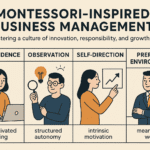Outline
Chapter 1: Foundations of Montessori in Business
- What is Montessori and Why Does it Matter in Business?
- Key Montessori Principles for Business Success
- The Role of the Environment in productivity
- Fostering Independence in Teams
- The Power of Self-Directed Learning
- Balancing Freedom and Structure in the Workplace
- The Concept of the Prepared Environment
- Observation as a Core Leadership Skill
- The Leader as a Guide, Not a Boss
- Redefining Success: Beyond Profits
Chapter 2: The Prepared Work Environment
- The Role of Physical Space in Business Efficiency
- Designing a Montessori-Inspired Office
- Open vs. Structured Workspaces: Finding the Balance
- Choosing the Right Tools and Resources for Employees
- Decluttering for Clarity and productivity
- Encouraging Employee Autonomy with a Thoughtful Layout
- Eliminating Distractions and Creating Focus Areas
- The Psychological Impact of Order in the Workplace
- Using Technology to Enhance the Prepared Environment
- Evolving and Adapting Workspaces Over Time
Chapter 3: Self-Directed Teams
- The Power of Autonomy in the Workplace
- Replacing Micromanagement with Trust
- Encouraging Employees to Take Initiative
- Establishing Clear Goals Without Dictating Methods
- Feedback as a Tool for Self-Directed Growth
- The Role of Collaboration in Independent Teams
- Problem-Solving Without Constant Supervision
- Building Internal Motivation in Employees
- Balancing Individual and Team Responsibilities
- Celebrating Autonomy-Driven Success
Chapter 4: Leadership as a Guide
- The Leader as a Facilitator, Not a Controller
- Leading with Patience and Understanding
- Coaching vs. Commanding in Leadership
- Asking the Right Questions to Inspire Thinking
- Encouraging Critical Thinking in Decision-Making
- Modeling the Behaviors You Want to See
- Supporting Employees Without Controlling Them
- Developing Leadership Skills in Team Members
- Trusting the Process and Letting Go of Control
- Fostering a Culture of Continuous Learning
Chapter 5: Observation-Driven Management
- The Art of Silent Observation in Leadership
- Identifying Strengths and Weaknesses in Teams
- Using Observation to Improve Decision-Making
- Understanding Group Dynamics Through Observation
- Knowing When to Intervene and When to Step Back
- Practicing Reflective Leadership
- Observing for Employee Development and Growth
- Tracking Progress Without Micromanaging
- Recognizing and Addressing Behavioral Patterns
- Adapting Strategy Based on Real-Time Insights
Chapter 6: Individualized Employee Development
- Understanding Different Learning Styles in the Workplace
- Creating Personalized Training Programs
- Encouraging Employees to Set Personal Growth Goals
- Supporting Self-Paced Learning in Professional Development
- Providing Resources for Skill-Building
- Building a Culture of Lifelong Learning
- Growth Mindset vs. Fixed Mindset in Employees
- The Role of Mentorship in Employee Growth
- Measuring Progress in Learning and Development
- Creating Sustainable Learning Pathways
Chapter 7: Freedom Within Limits
- Setting Clear Boundaries Without Stifling Creativity
- Encouraging Innovation While Maintaining Structure
- Allowing Risk-Taking Without Chaos
- Defining Company Policies That Foster Autonomy
- Managing Time Without Over-Scheduling
- Creating a Balance Between Collaboration and Independence
- Teaching Accountability Without Fear-Based Tactics
- Handling Mistakes as Learning Opportunities
- Structuring Systems for Autonomous Work
- Trusting Employees to Self-Manage Their Workflows
Chapter 8: Intrinsic Motivation and Employee Engagement
- The Psychology Behind Intrinsic vs. Extrinsic Motivation
- Building a Purpose-Driven Workplace Culture
- Encouraging Passion and Commitment in Employees
- Recognizing Effort Instead of Just Outcomes
- Empowering Employees to Set Their Own Challenges
- Using Meaningful Work as a Long-Term Motivator
- Avoiding Incentives That Kill Internal Motivation
- Aligning Business Goals with Employee Aspirations
- Creating a Sense of Ownership in Teams
- Sustaining Motivation Through Continuous Growth
Chapter 9: Conflict Resolution the Montessori Way
- Understanding Conflict Through Non-Judgmental Observation
- Encouraging Employees to Resolve Conflicts Independently
- The Role of Active Listening in Conflict Management
- Creating a Safe Space for Difficult Conversations
- Teaching Empathy and Emotional Intelligence in Teams
- Preventing Power Struggles in the Workplace
- Developing a Step-by-Step Approach to Conflict Resolution
- Encouraging Mediation Before Escalation
- Turning Workplace Disagreements into Learning Experiences
- Building a Culture of Mutual Respect and Understanding
Chapter 10: Sustainable Business Growth Through Montessori Principles
- Long-Term Impact of Montessori-Inspired Leadership
- Applying Continuous Improvement for Business Growth
- Maintaining Work-Life Balance to Prevent Burnout
- Avoiding Leadership and Employee Exhaustion
- Creating Scalable Systems That Empower People
- The Role of Ethical Decision-Making in Growth
- Aligning Business Goals with Social and Environmental Impact
- Encouraging Lifelong Learning as a Business Strategy
- Evolving the Montessori Spirit in a Changing Workplace
- Creating a Business That Grows with Purpose















